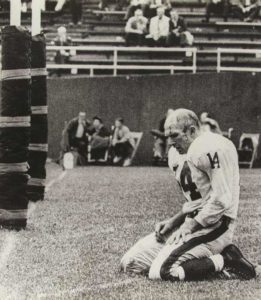 Today, I have a story appearing in both the Charlotte Observer and The News & Observer offering tips for parents of student athletes as the busy falls sports season gets underway. The story focuses primarily on the emotional issues that often arise. Below is a look at the physical side of high school athletics, with information and tips on injuries and injury prevention.
Today, I have a story appearing in both the Charlotte Observer and The News & Observer offering tips for parents of student athletes as the busy falls sports season gets underway. The story focuses primarily on the emotional issues that often arise. Below is a look at the physical side of high school athletics, with information and tips on injuries and injury prevention.
If you have a high school athlete, there’s a 1 in 5 chance he or she will suffer a physical injury.
In the 2009-2010 school year, the latest year for which stats are available, 1.35 million of the nation’s 7 million high school athletes got injured, according to the Center for Injury Research & Policy at the Research Institute at Nationwide Children’s Hospital in Columbus, Ohio. To be a certified injury, the incident had to require medical attention (doctor, athletic trainer, emergency personnel) and result in the athlete missing at least one lost day of practice or a game.
Some highlights from that study:
Injuries by sport
Injuries per 1,000 players.
Football: 3.81 injuries
Girls soccer: 2.0
Wrestling (boys): 1.98
Boys soccer: 1.75
Girls basketball: 1.58
Boys basketball: 1.45
Girls volleyball: 0.99
Softball (girls): 1.12
Baseball (boys): 0.82
Mostly commonly injured body part
Reflects percent of total injuries.
Ankle: 17.5
Head/face: 17.2
Knee: 15.7
Hand/wrist: 10.3
Hip/thigh/upper leg: 9.2
Shoulder: 8.4
Trunk: 5.8
Lower leg: 4.7
Foot: 4.1
Arm/elbow: 4.0
Neck: 1.9
Other: 1.0
Bench time
Number of days (practices and games) missed due to injury.
1-2 days: 14.7 percent
3-6 days: 27.3 percent
7-9 days: 16.1 percent
10-21 days: 16.9 percent
22 or more days: 25.0 percent
Injuries by class
Percentages of injuries by year in school, broken down by male and female athletes.
Freshman: 20.8 percent | 27.9 percent
Sophomore: 23.5 percent | 26.7 percent
Junior: 25.8 percent | 24.1 percent
Senior: 29.9 percent | 21.3 percent
Check out the entire report here. For comparison sake, check out this study of the 2005-06 school year by the Centers for Disease Control and Prevention.
* * *
Hydration
Hydration is a particularly important issue for so-called “fall” sports — practice for some of which began over a month ago, in the dead of summer. If your student athlete is fatigued, irritable, unproductive and is suffering headaches and muscle cramps, he or she might be dehydrated.
Here’s a good overview of dehydration that ran in the New York Times last year: “In Summer’s Heat, Watch What You Drink.”
For a succinct take on recognizing dehydration and getting rehydrated, here’s what the Mayo Clinic has to say.
Playing hurt
“If you get hurt,” advises the National Institutes of Health, “stop playing. Continuing to play or exercise can cause more harm.”
Schools and coaches have gotten better about sidelining injured players until they’re ready to return. Still, there’s often subtle suggestion that an athlete “gut it out” that puts injured players on the field before they’re ready.
For most non-serious injuries, follow the RICE (Rest, Ice, Compression and Elevation) approach to recovery. That will help relieve pain, reduce swelling and speed healing.
For more on sports injuries, check out the Sports Injuries section of MedlinePlus, a service of the NIH and U.S. National Library of Medicine.
Cheerleading
60 percent of cheerleading injuries are the result of stunts, according to a study by the Center for Injury Research and Policy of The Research Institute at Nationwide Children’s Hospital. By stunts, they mean: cradles, elevators, extensions, pyramids, single-based stunts, single-leg stunts, stunt-cradle combinations, transitions and miscellaneous-partner-and-group stunts.
The most common injuries were strains and sprains (53 percent). Injuries occurred most frequently during practice (83 percent). The top five body parts injured were the ankle (16 percent), knee (9 percent), neck (9 percent), lower back (7 percent) and head (7 percent).
Photo: The famous “my-achin’-everything” photo of NFL quarterback Y.A. Tittle after a loss in 1964, his last season. In addition to his bloodied face, Tittle was thought to have a concussion and possible broken ribs.